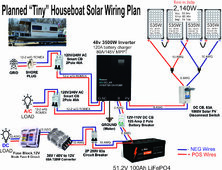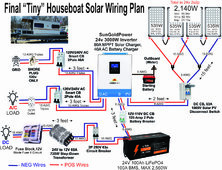1. The solar diagram is correct- it is 2s2p (not 2c2p) it stands for 2 in series (the left side of the diagram) and 2in parallel (the left and right side together).
2. You do not need to fuse panels that have less than three in parallel. Three in parallel or more REQUIRES a fuse in each parallel section. You may (Will) want to have a solar disconnect so you can “turn the sun off” for maintenance and storage.
3. For the Victron stuff, it is sold by dealers that will provide support (if needed). My Victron dealer is

 www.continuousresources.com
www.continuousresources.com
You may have a good dealer closer to you. Discuss your project with them, send them your plan, let them help you and make sure you haven’t forgotten something.
I will respond more later.
2. You do not need to fuse panels that have less than three in parallel. Three in parallel or more REQUIRES a fuse in each parallel section. You may (Will) want to have a solar disconnect so you can “turn the sun off” for maintenance and storage.
3. For the Victron stuff, it is sold by dealers that will provide support (if needed). My Victron dealer is

SOLAR POWER SYSTEMS AND COMPONENTS
We make renewable energy more accessible for homes and businesses by providing quality solar power system components, including solar panels, solar power invert
You may have a good dealer closer to you. Discuss your project with them, send them your plan, let them help you and make sure you haven’t forgotten something.
I will respond more later.




